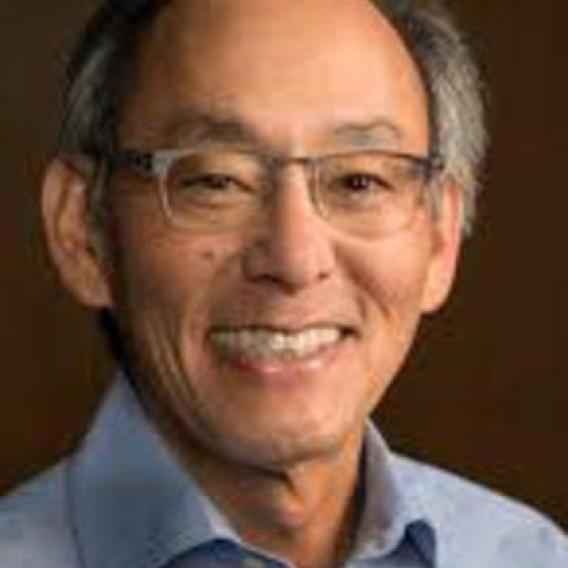Image

Steven Chu
Professor, Physics
Professor, Molecular and Cellular Physiology
Professor, Energy Science & Engineering
Member, Bio-X
Member, Wu Tsai Neurosciences Institute
Ph.D., University of California, Berkeley, Physics (1976)
B.S., University of Rochester, Physics (1970)
A.B., University of Rochester, Mathematics (1970)
Affiliation:
Steven Chu is the William R. Kenan, Jr. Professor of Physics, of Molecular and Cellular Physiology, and of Energy Science and Engineering at Stanford University. He received an A.B. degree in mathematics and a B.S. degree in physics from the University of Rochester, and a Ph.D. in physics from the University of California, Berkeley. After a postdoctoral fellowship at Berkeley, he was at Bell Labs as a member of the technical staff in 1978 and then department head in 1983.
From January 2009 to April, 2013, Dr. Chu served as U.S. Secretary of Energy under President Barack Obama. During his tenure, he began several initiatives, including ARPA-E (Advanced Research Projects Agency – Energy), the Energy Innovation Hubs, and the Clean Energy Ministerial meetings. As the first scientist Cabinet member, Chu recruited dozens outstanding scientists and engineers to the Department of Energy, and was personally tasked by President Obama to help stop the BP Oil leak.
From 2004-2009, he was the director of the Lawrence Berkeley National Laboratory and Professor of Physics and of Molecular and Cell Biology at the University of California Berkeley. Prior to those positions, he was the Theodore and Francis Geballe Professor of Physics and Applied Physics at Stanford University. During this time, he helped start Bio-X, a multi-disciplinary initiative combining the physical and biological sciences with engineering and medicine.
His contributions include the introduction of laser cooling and optical trapping of atoms and particles, atomic fountain clocks and atom interferometers, the optical tweezers of biomolecules, and single molecule FRET of biomolecules tethered to surfaces. His current research is in biophysics, molecular and cellular physiology, medical imaging, nanoparticle synthesis and battery research. He has received many awards, including the 1997 Nobel Prize for laser cooling and optical trapping of atoms. He is a member of the National Academy of Sciences, the American Philosophical Society, the American Academy of Arts and Sciences, National Academy of Inventors, and a foreign member of the Royal Society, the Royal Academy of Engineering, the Chinese Academy of Sciences, the Academia Sinica, the Korean Academy of Sciences and Technology and the Pontifical Academy of Sciences.
He received an A.B. degree in mathematics, and a B.S. degree in physics from the University of Rochester, and a Ph.D. in physics from the University of California, Berkeley, and 35 honorary degrees.
From January 2009 to April, 2013, Dr. Chu served as U.S. Secretary of Energy under President Barack Obama. During his tenure, he began several initiatives, including ARPA-E (Advanced Research Projects Agency – Energy), the Energy Innovation Hubs, and the Clean Energy Ministerial meetings. As the first scientist Cabinet member, Chu recruited dozens outstanding scientists and engineers to the Department of Energy, and was personally tasked by President Obama to help stop the BP Oil leak.
From 2004-2009, he was the director of the Lawrence Berkeley National Laboratory and Professor of Physics and of Molecular and Cell Biology at the University of California Berkeley. Prior to those positions, he was the Theodore and Francis Geballe Professor of Physics and Applied Physics at Stanford University. During this time, he helped start Bio-X, a multi-disciplinary initiative combining the physical and biological sciences with engineering and medicine.
His contributions include the introduction of laser cooling and optical trapping of atoms and particles, atomic fountain clocks and atom interferometers, the optical tweezers of biomolecules, and single molecule FRET of biomolecules tethered to surfaces. His current research is in biophysics, molecular and cellular physiology, medical imaging, nanoparticle synthesis and battery research. He has received many awards, including the 1997 Nobel Prize for laser cooling and optical trapping of atoms. He is a member of the National Academy of Sciences, the American Philosophical Society, the American Academy of Arts and Sciences, National Academy of Inventors, and a foreign member of the Royal Society, the Royal Academy of Engineering, the Chinese Academy of Sciences, the Academia Sinica, the Korean Academy of Sciences and Technology and the Pontifical Academy of Sciences.
He received an A.B. degree in mathematics, and a B.S. degree in physics from the University of Rochester, and a Ph.D. in physics from the University of California, Berkeley, and 35 honorary degrees.